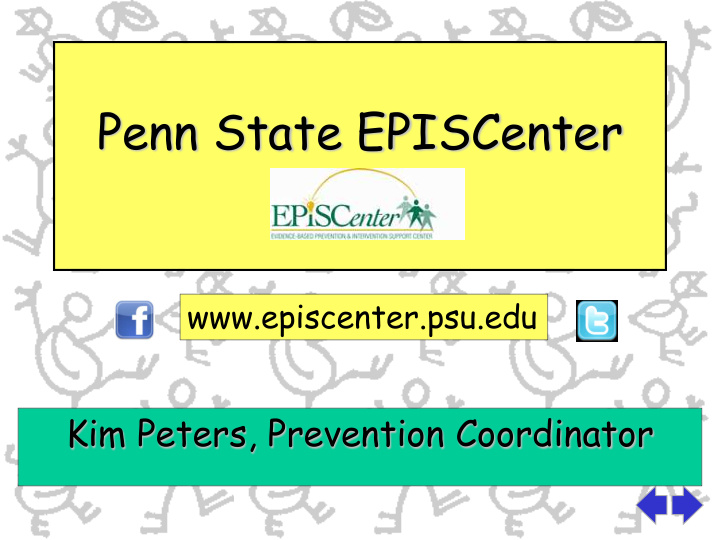



Penn State EPISCenter www.episcenter.psu.edu Kim Peters, Prevention Coordinator
WHAT IS PATHS?
PATHS STANDS FOR… P ROMOTING A LTERNATIVE TH INKING S TRATEGIES
Paths is a curriculum for Educators ~ TEACHERS ~ SUPPORT STAFF ~PRINCIPALS ~PARENTS
Weekly or bi-weekly lessons in Pre- K-5 th grades Group Discussions Role-Playing Skits Art Activities Stories Educational Games Home Assignments
What are the Goals of PATHS? Paths is a curriculum designed to help children learn: • Emotional Understanding • Self-Control • Interpersonal Problem-Solving Skills
Emotional Understanding • Learn cues to recognize feelings • Learn the relationship between feelings and behaviors • Learn how their behaviors affect their relationship with others
Core Emotion Concepts • We all have feelings. • All feelings are OK. • Feelings are either comfortable or uncomfortable. • Emotions and behaviors are different. • Feelings provide critical information. • Emotion awareness, labeling, and communication are important. • Feelings are personal. • Feelings vary in intensity. • Feelings change.
PKD & Compliments When kids feel good about themselves, they are more ready to learn, make better choices and want to be involved in a positive way. PATHS uses compliments as a way to increase self esteem You acknowledge positive qualities in others and in yourself.
Self-Control • Learn how to stop and think before acting • Learn special techniques to stay calm and in control
The Turtle Technique 1: Say, “Stop” 2: Take a long deep breath 3: Say the problem and how you feel.
Three Steps for Calming Down
Control Signals Poster • Stop • Think and make a Plan • Go
Interpersonal Problem- Solving Skills • What’s the problem? • What are my alternatives? • Which alternative is the best? • Trying my plan • How did it work?
Problem-Solving Outline 1. STOP and think. 2. Identify the PROBLEM. (collect lots of information) 3. Identify the FEELINGS. (your own and other peoples') 4. Decide on a GOAL. 5. Think of lots of SOLUTIONS. 6. Think about what MIGHT happen next. 7. Choose the BEST solution. (evaluate all the alternatives) 8. Make a PLAN. (think about possible obstacles) 9. TRY your plan. 10. SEE what happens. (evaluate the outcome) 11. TRY another plan or solution if your first one doesn't work.
Why teach PATHS? Effective social skills enhance… • Self-Esteem • Academic Performance
In rigorous clinical studies*, the PATHS program has been shown to : • reduce teachers' reports of students exhibiting aggressive behavior by 32% • increase teachers' reports of students exhibiting self -control by 36% • increase reports of prosocial peer relations • significantly improve students' ability to tolerate frustration • increase students' scores on cognitive skills tests by 20% • increase students' vocabulary for emotions by 68% • increase students’ ability to use effective conflict resolution strategies • reduce depression and sadness among special -needs students. *at one- or two-year follow-up, compared to matched-comparison children There have been four controlled studies with randomized control groups: 2 with regular education children, 1 with special needs children, and 1 with deaf/hearing-impaired children.
Pennsylvania Commission on Crime and Delinquency (PCCD) • Evidence-based program initiative – Aggression Replacement Training – Big Brothers Big Sisters – LifeSkills Training – Olweus Bullying Prevention Program – Project Towards No Drug Abuse – Promoting Alternative THinking Strategies – Strengthening Families Program for Parents & Youth 10-14 – The Incredible Years
Applying for PCCD Funds PCCD Website http://www.portal.state.pa.us/portal/server.pt/community/pccd_home/5226 Spring 2012 EBP RFP Click on Grant Information How the Grant Process Works Subscribe to Get Funding Opportunities Notices
Thank You… Too often we give children answers to remember rather than problems to solve. Roger Lewin Kim Peters, Penn State EPISCenter kpeters@episcenter.org
Recommend
More recommend